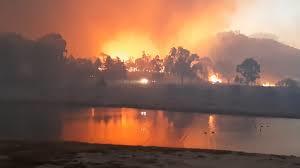How To Prepare for and deal with Wildfires
As Australia is learning, wildfires are extremely dangerous. We had one here in the Smokies a couple of years ago that killed a bunch of people. Driving through not long after, you can hardly see the damage to the forest; but you can see the houses that burned. It moved so fast the trees were barely burnt.

First,
know when the danger is high. If there’s been drought, that heightens
the risk. High winds help push it. Watch the special on the Paradise
fires in CA and you’ll get an idea how fast it moves.
All fires start small. All fires go out. What matters is what happens in between.
The
wind throws embers one mile or more ahead of the flames. These embers
start new fires. A fast wild fire has an intense wall of heat in front
of it. Even if the flames haven’t arrived, it will combust the most
flammable material.
As
the main fire approaches your house, strong winds blow embers
everywhere possible – under decks, against wood fences, into woodpiles,
and through open doors and windows.
In some places the air is so smoky that you can’t see more than 10 feet.
Close to where the fire is burning most intensely, the air is far too hot to breathe.
The rising smoke and ash create winds on the ground which cause the fires to burn even more intensely.
Fires
like this occur every year. Wild fires don’t just happen in the summer;
in many areas fires can happen year round. When it is dry and windy be
watchful and prepare to take action to protect your family and property.
To prepare your home if you live in an area prone to wildfires, here is a list of things to do:
Keep your roof and gutters free of leaves.
Store
firewood at least 30 feet away from structures. The nice pile against
the side of your house is called fuel for a wildfire.
Your outdoor furniture should be made of noncombustible materials.
Clear
the area around your house of combustible material such as leaves,
bark, pine needles and underbrush. Especially trim grass and brush
around your propane tank. Optimally you want a hundred foot barrier of
no trees, shrubs or bushes around your house.
When building walls, barriers, gates, landscaping, etc use noncombustible materials.
When
evacuating a wildfire, you should leave as soon as you receive notice.
Considering there is a chance your house might not be there for you to
come back to, besides your GnG bag, also take that fireproof container
with all your key documents in it. And your pets. Beyond that, forget
about it.
While evacuating, make sure you have enough gas. This goes back to always keeping your tank at least half full.
Leave any gates open for firefighters and others.
Drive with headlights on. If it’s smoky, close all windows, and recirculate air inside the vehicle.
If
you get trapped, park in an area that is clear of vegetation (parking
lot, gravel area, dirt), close all windows and vents, cover yourself
with a blanket or coat and lie on the floor. Car tires may burst from
heat.
In an
extreme situation, you have to consider whether you can stay in your
house only if: your only escape route is blocked; smoke is so thick you
can’t travel; you don’t have time to evacuate; or emergency personnel
tell you to.
You
cannot stay in your house if: you have wood siding or shingles; you’re
located in a narrow canyon or on a steep slope; you have a lot of
vegetation close around the house. Find a neighbor with a better house.
If you do stay in a house, do the following: use a sprinkler or the sprinkler system to wet the yard. Wet the roof with a hose. Turn off all propane and gas. Close all windows and doors. Move fabric covered furniture away from large windows or sliding doors. Turn off everything that circulates air through the house. Close all interior doors.
Excerpted from The Green Beret Preparation and Survival Guide



